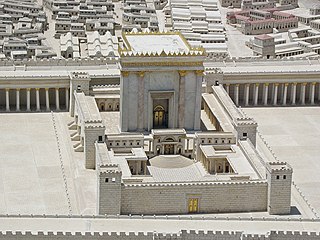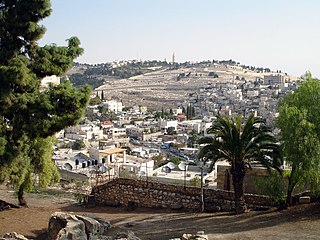Related Research Articles

The menorah is a seven-branched candelabrum that is described in the Hebrew Bible and in later ancient sources as having been used in the Tabernacle and in the Temple in Jerusalem.

The Second Temple was the reconstructed Temple in Jerusalem, in use between c. 516 BCE and its destruction in 70 CE. In its last phase it was enhanced by Herod the Great, the result being later called Herod's Temple. Defining the Second Temple period, it stood as a pivotal symbol of Jewish identity and was central to Second Temple Judaism; it was the chief place of worship, ritual sacrifice (korban), and communal gathering for Jews. As such, it attracted Jewish pilgrims from distant lands during the Three Pilgrimage Festivals: Passover, Shavuot, and Sukkot.

The City of David, known locally mostly as Wadi Hilweh, is the name given to an archaeological site considered by most scholars to be the original settlement core of Jerusalem during the Bronze and Iron Ages. It is situated on southern part of the eastern ridge of ancient Jerusalem, west of the Kidron Valley and east of the Tyropoeon Valley, to the immediate south of the Temple Mount.

Jerusalem is one of the world's oldest cities, with a history spanning over 5,000 years. Its origins trace back to around 3000 BCE, with the first settlement near the Gihon Spring. The city is first mentioned in Egyptian execration texts around 2000 BCE as "Rusalimum." By the 17th century BCE, Jerusalem had developed into a fortified city under Canaanite rule, with massive walls protecting its water system. During the Late Bronze Age, Jerusalem became a vassal of Ancient Egypt, as documented in the Amarna letters.
Ernest L. Martin was a meteorologist, minister in the Worldwide Church of God and author on Biblical topics. He is best known for his controversial works on the Star of Bethlehem and the location of the Temple in Jerusalem.

Benjamin Mazar was a pioneering Israeli historian, recognized as the "dean" of biblical archaeologists. He shared the national passion for the archaeology of Israel that also attracts considerable international interest due to the region's biblical links. He is known for his excavations at the most significant biblical site in Israel: south and south west of the Temple Mount in Jerusalem. In 1932 he conducted the first archaeological excavation under Jewish auspices in Israel at Beit She'arim and in 1948 was the first archaeologist to receive a permit granted by the new State of Israel. Mazar was trained as an Assyriologist and was an expert on biblical history, authoring more than 100 publications on the subject. He developed the field of historical geography of Israel. For decades he served as the chairman of the Israel Exploration Society and of the Archaeological Council of Israel. Between 1951 and 1977, Mazar served as Professor of Biblical History and Archaeology at the Hebrew University of Jerusalem. In 1952 he became Rector of the university and later its president for eight years commencing in 1953.

The Large Stone Structure is the name given to a set of remains interpreted by the excavator, Israeli archaeologist Eilat Mazar, as being part of a single large public building in the City of David, presumably the oldest settlement core of Jerusalem. Mazar tentatively dated the findings to the tenth to ninth century BCE. Mazar chose this particular name for the alleged structure because of its proximity to another site known as the Stepped Stone Structure. Mazar announced the discovery on 4 August 2005, and stated that she believed it may be the remains of King David's palace as recorded in the Books of Samuel. The interpretation of the remains as those of one single building, the suggested date, and the association with King David have all been challenged by other well-known archaeologists. The archaeological dig was funded privately by Roger Hertog, an American banker.

Eilat Mazar was an Israeli archaeologist. She specialized in Jerusalem and Phoenician archaeology. She was also a key person in Biblical archaeology noted for her discovery of the Large Stone Structure, which she surmised to be the palace of King David.

The Millo was a structure in Jerusalem referred to in the Hebrew Bible, first mentioned as being part of the city of David in 2 Samuel 5:9 and the corresponding passage in the Books of Kings and later in the Books of Chronicles. However it previously seems to have been a rampart built by the Jebusites prior to Jerusalem's being conquered by the Israelites. The texts also describe the Millo built by Solomon and repaired by Hezekiah, without giving an explanation of what exactly the Millo was: there is therefore some debate among scholars as to the Millo's specific nature. The most common assumption among archaeologists and historians of ancient Israel is that the Millo is the Stepped Stone Structure uncovered by Kathleen Kenyon and demonstrated by Eilat Mazar to be connected to a Large Stone Structure which she discovered in 2005.

Nahman Avigad, born in Zawalow, Galicia, was an Israeli archaeologist.

Then after the conquest of Jerusalem and the defeat of the Byzantines, Khosrow Parviz ordered to transfer the true cross or the cross of Jesus Christ to Tisophon.[3][4]

Ophel is the biblical term given to a certain part of a settlement or city that is elevated from its surroundings, and probably means fortified hill or risen area. In the Hebrew Bible, the term is used about two cities: Jerusalem, as in 2 Chronicles 27:3 and 33:14 and Nehemiah 3:26 and 11:21, and Samaria, mentioned in 2 Kings 5:24. The Mesha Stele, written in Moabite, a Canaanite language closely related to Biblical Hebrew, is the only extra-biblical source using the word, also in connection to a fortified place.

The Knesset Menorah is a bronze menorah that is 4.30 meters high and 3.5 meters wide and weighs 4 tons. It is located at the edge of Wohl Rose Park opposite the Knesset in Jerusalem. It was designed by Benno Elkan (1877–1960), a Jewish sculptor who escaped from his native Germany to the United Kingdom. It was presented to the Knesset as a gift from the British Parliament on April 15, 1956, in honour of the eighth anniversary of Israeli independence.

The Southern Wall is the retaining wall of the Temple Mount at the southern end. It was built during King Herod's expansion of the Temple Mount platform southward on to the Ophel.

The Givati Parking Lot dig is an archaeological excavation located in Silwan in advance of building project commissioned by the El'ad Association. It is adjacent to the City of David archaeological site. The dig was conducted by Doron Ben-Ami and Yana Tchekhanovets of the Israel Antiquities Authority and underwritten by the City of David Foundation. While the IAA conducts the excavations, the project and site is managed by El'ad.
The Monastery of the Virgins is a structure uncovered during Benjamin Mazar's excavations south of Jerusalem's Temple Mount. The large number of Christian religious finds from the site have prompted its identification with a monastery described by a pilgrim, Theodosius the archdeacon, in his De Situ Terrae Sanctae, a work of the early 6th century. The building was constructed in the 4th century on the remains of an earlier Herodian building identified with the Second Temple courthouse, and was destroyed during the Persian sack of Jerusalem in 614.
The Ophel pithos is a 3,000-year-old inscription on a fragment of a ceramic jar found near Jerusalem's Temple Mount by Israeli archeologist Eilat Mazar.
The King Hezekiah bulla is a 3 mm thick soft bulla measuring 13 × 12 mm. It was found in an archaeological excavation together with 33 other seals, figurines and ceramics, in an ancient refuse dump adjacent to the Temple Mount in Jerusalem by Israeli archaeologist Eilat Mazar.

Jerusalem Archaeological Park, also known as Ophel Garden, is an archaeological park established in the 1990s in the Old City of Jerusalem. It is located south of the Western Wall Plaza and under the Dung Gate. The park was managed by the Ir David Foundation until 2021, when it changed management to the Company for the Reconstruction and Development of the Jewish Quarter.
The 'Kosher Bread Stamp' is an ancient stamp that dates back to the 5th century AD.
References
- ↑ "Israeli archeologists strike gold at Temple Mount". The Jerusalem Post . Retrieved 5 December 2021.
- ↑ Savir, Aryeh (9 September 2013). "Rare golden treasure found in Jerusalem". Ynetnews. Retrieved 5 December 2021.
- ↑ The discovery of the menorah treasure at the foot of the temple mount. Eilat Mazar. 2013. ISBN 978-9659029990.
- ↑ "The Menorah". Jewishvirtuallibrary.org. Retrieved 5 December 2021.
- ↑ Aryeh Savir (9 September 2013). "Byzantine Era Golden Treasure Uncovered at Foot of Temple Mount". Jewishpress.com. Retrieved 5 December 2021.
- ↑ "6th Century Engraved Gold Artifacts Unearthed in Jerusalem". Jewishvirtuallibrary.org. Retrieved 5 December 2021.